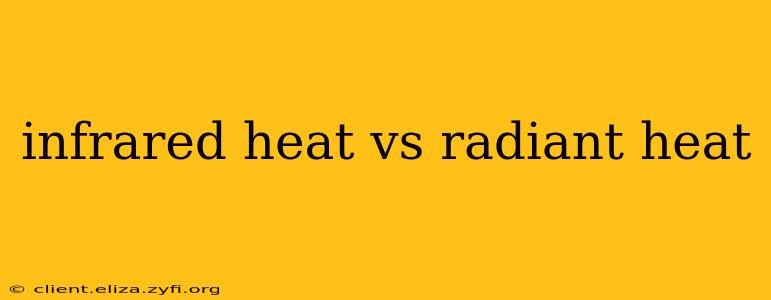The terms "infrared heat" and "radiant heat" are often used interchangeably, leading to confusion. While closely related, there's a crucial distinction: infrared heat is a type of radiant heat, but not all radiant heat is infrared. Let's break down the nuances to clarify the differences and explore their applications.
What is Radiant Heat?
Radiant heat is a form of heat transfer that occurs through electromagnetic waves. These waves travel at the speed of light and don't require a medium (like air or water) to transfer heat. Think of the sun warming your face – that's radiant heat in action. The sun emits various types of electromagnetic radiation, including infrared radiation, visible light, and ultraviolet radiation. All of these contribute to the radiant heat we feel.
What is Infrared Heat?
Infrared (IR) radiation is a specific part of the electromagnetic spectrum, encompassing wavelengths longer than visible light but shorter than microwaves. It's a type of radiant heat that we experience as warmth. Different objects emit infrared radiation at varying intensities depending on their temperature. The hotter the object, the more intense the infrared radiation it emits.
How are Infrared and Radiant Heat Related?
As mentioned, infrared radiation is one form of radiant heat. However, other forms of electromagnetic radiation, such as visible light, can also contribute to radiant heat. For instance, a glowing electric heater transfers heat through both visible light and infrared radiation, resulting in a combined radiant heat effect. A fireplace, on the other hand, generates radiant heat primarily through infrared radiation, alongside some visible light.
H2: What are the different types of infrared heat?
Infrared radiation is further categorized into near-infrared (NIR), mid-infrared (MIR), and far-infrared (FIR), based on their wavelengths. Each type has slightly different properties and applications:
- Near-infrared (NIR): Shorter wavelengths, penetrates deeper into materials, often used in industrial heating and drying processes.
- Mid-infrared (MIR): Medium wavelengths, used in various applications including thermal imaging and gas detection.
- Far-infrared (FIR): Longer wavelengths, absorbed more readily by the surface of materials, often used in heating applications designed for human comfort.
H2: What are the benefits of infrared heating?
Infrared heating offers several advantages over other heating methods such as convection:
- Direct heating: Infrared heat targets objects directly, heating them rather than the air around them. This leads to faster heating and better energy efficiency.
- Targeted heating: You can use infrared heaters to heat specific areas, reducing overall energy consumption compared to heating an entire space.
- Health benefits (potential): Some studies suggest that far-infrared radiation can promote blood circulation and other health benefits, although more research is needed. However, this needs to be balanced with the potential for skin burns and overheating if not used responsibly.
H2: What are some applications of infrared heating?
Infrared heating is utilized across a wide range of applications, including:
- Industrial heating: Drying, curing, and heating materials in manufacturing processes.
- Commercial heating: Heating large spaces like warehouses or workshops.
- Residential heating: Supplemental or primary heating in homes, using infrared panels or heaters.
- Therapeutic applications: Infrared saunas utilize far-infrared radiation for relaxation and purported health benefits.
H2: What are the differences between infrared heating and other heating methods (like convection)?
Convection heating warms the air, which then transfers heat to objects and people in the space. This is less efficient than direct heating with infrared radiation. Infrared heating provides a more immediate and focused warmth, as mentioned previously.
H2: Is infrared heating safe?
Infrared heating is generally safe when used correctly. However, prolonged exposure to high-intensity infrared radiation can cause skin burns or other damage. It's crucial to follow manufacturer's instructions and maintain a safe distance from infrared heaters.
In summary, while infrared heat is a type of radiant heat, radiant heat encompasses a broader spectrum of electromagnetic waves. Understanding these nuances helps you appreciate the specific advantages and applications of infrared heating in various settings. Remember always to prioritize safety when using any heating device.
